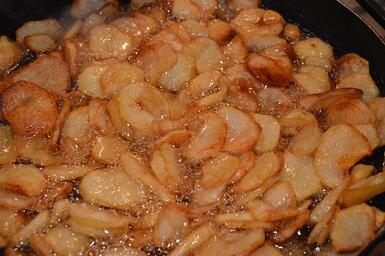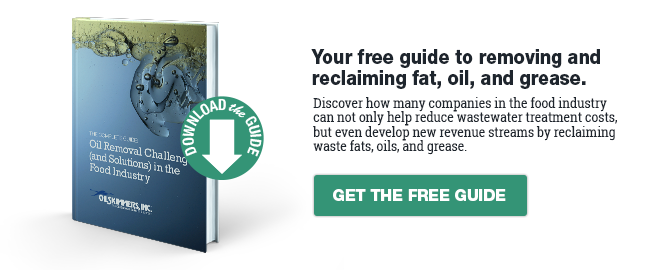 Whether you are washing down farm equipment, transporting edible
oils, cooking meat, or manufacturing food packaging, in each segment of the vast food and beverage industry
there is a universal problem: fat, oil and grease (FOG) in wastewater.
Whether you are washing down farm equipment, transporting edible
oils, cooking meat, or manufacturing food packaging, in each segment of the vast food and beverage industry
there is a universal problem: fat, oil and grease (FOG) in wastewater.
Without effective and efficient oil removal solutions in place, food and beverage companies can face increased costs for water treatment and discharge, maintenance concerns, and environmental compliance issues, among other problems.
Does fat, oil or grease end up in the wash water or wastewater in your application? Are you aware of the oil removal solutions available?
The following are eight sources of FOG that you can manage to decrease costs and unlock greater profits. Read on to see if any of these might apply to your operations. And, download the eBook to take action and determine the right solution.
1. Farm Equipment
To plant and harvest crops, farms use tractors, planters, seeders, sprayers, combines and other types of large machinery. The problem is, the lubricants and hydraulic oil required to operate this machinery can leak and end up in wastewater.
2. Oil Extraction
Edible oils used as ingredients or to cook food are extracted from plants using one of three methods:
- Cold pressed. A mechanical, chemical-free process that is temperature controlled
- Expeller pressed. A mechanical, chemical-free process used for harder nuts and seeds that require more pressure, which creates more heat.
- Distillation. Material is dissolved in a solvent like hexane, and then the solvent evaporates in a distillation process, leaving just the oil.
In each of these processes, oil coats the equipment, can spill or leak, and ultimately ends up in wastewater when the equipment is cleaned and washed down.
3. Oil Transport
Edible oils are commonly transported in tank trucks to packagers or to facilities that use the oil in their own products or processes. The trucks can experience spills and leaks when the oil is transferred, leading two areas susceptible to unwanted oil: delivery areas and truck wash bays. When it rains, when the lots and delivery areas are washed, and when the tank trucks are washed out, both oil and water flow to a sump or collection pit.
4. Oil Used for Cooking or as an Ingredient
Many packaged foods companies use oil for cooking, frying or as an ingredient. In each case, oil routinely coats equipment and machinery. To meet regulations for clean facilities, regular washing is required. Cleaning the oily surfaces causes oil and wash water to mix, ultimately requiring further treatment prior to wastewater discharge.
5. Fat, Oil and Grease from Meat and Fish
Meat and fish processing are inherently prone to FOG byproducts. During slaughter, processing and cooking, residual animal fat and natural oils are washed away into the wastewater stream.
6. Oil from Manufacturing Containers
Not only is food processing susceptible to FOG problems but packaging the food can be too. Packaging options—including paper, cardboard, plastic, glass and metal—each involve processes with equipment that can leak lubrication and hydraulic oils into wastewater, which must be removed before water is discharged.
7. Canning Foods and Beverages
At beverage canning facilities, a can seamer is used to seal the lid onto the body of a can. The seamer requires constant lubrication to ensure the integrity of the seam is maintained and corrosion on parts of the machine is prevented. Seamer oil may seep out of the machine during the canning process and find its way into the facility’s wastewater stream.
8. Cooking Food for Consumption
The final source of FOG during the food and beverage production process occurs at restaurants, cafeterias and mess halls on military bases. These facilities use and produce a lot of FOG when preparing and cooking meals. Waste oil, fat and grease is funneled to a grease trap where it can quickly build up.
Discover the Solution to Fat, Oil and Grease in the Food Industry: New Guide
Ready to learn more about oil removal solutions and take action? Our team of experts at Oil Skimmers, Inc. compiled a new guide that explores these eight sources of FOG and proven solutions to help those with similar applications determine the right oil recovery methods for their particular application.
For more information, download The Complete Guide: Oil Removal Challenges (and Solutions) in the Food Industry.

